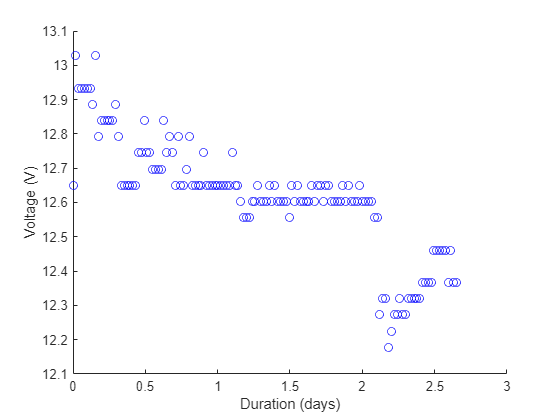Read ThingSpeak Data and Predict Battery Discharge Time with Linear Fit
This example shows how to read battery data from a ThingSpeak™ channel and analyze the data to determine the remaining battery life. Use a linear fit to predict the date that the battery will fail, and then write the remaining time in days to another ThingSpeak Channel. You read data for a 12 V battery connected to a microprocessor reporting its voltage to ThingSpeak every half hour. Then use regression to predict the day and time when the battery will fail.
Read Data from ThingSpeak Channel
Start by storing channel and date information in variables, and then use thingSpeakRead to read the data. Channel 592680 shows the scaled measurement of voltage from a 12 V battery. Use the DateRange name-value pair to use a specific selection of data.
batteryChannelID = 592680; startDate = datetime('Oct 20, 2018'); endDate = datetime('Oct 23, 2018'); batteryData = thingSpeakRead(batteryChannelID,'DateRange',[startDate endDate],'Outputformat','Timetable');
Convert the Data for Fitting and Plot
The channel stores raw data from the device. Convert the analog-to-digital converter (ADC) measurement to voltage using the experimentally determined conversion factor 14.6324. Convert the timestamps into durations of days, then use scatter to generate a plot.
myVoltage = 14.6324 * batteryData.Voltage; battTimes = batteryData.Timestamps; battTimes = days(battTimes-battTimes(1)); scatter(battTimes,myVoltage,'b'); xlabel('Duration (days)'); ylabel('Voltage (V)'); hold on

Fit the Data
The timetable datetime format is useful for reading and plotting. Use polyfit to perform linear regression on the data, and polyval to evaluate the fit at the existing time values. Add the fit line to the previous plot.
fitCoeffs = polyfit(battTimes,myVoltage,1);
fitLine = polyval(fitCoeffs,battTimes);
plot(battTimes,fitLine,'r--');
Predict Discharge Time
The battery should not be discharged below 10.4 V. Using the slope and intercept from fitCoeffs, find the number of days until the fit line will intersect with this voltage.
endDays = (10.4-fitCoeffs(2))/fitCoeffs(1)
endDays = 13.1573
There are just over 13 days until the battery dies.
Write Prediction to ThingSpeak
The thingSpeakWrite function writes the result to a ThingSpeak channel. Return the output from thingSpeakWrite to ensure a successful write operation. Change the writeChannelID and writeAPIKey to write to your own channel.
writeChannelID = 17504; writeAPIKey='23ZLGOBBU9TWHG2H'; result = thingSpeakWrite(writeChannelID,round(endDays,4),'WriteKey',writeAPIKey)
result = struct with fields:
Field1: '13.1573'
Field2: []
Field3: []
Field4: []
Field5: []
Field6: []
Field7: []
Field8: []
Latitude: []
Longitude: []
ChannelID: 17504
Created: 10-May-2024 11:01:22
LastEntryID: 866419
Altitude: []
The result shows the successful write operation and reports the data that was written.
See Also
thingSpeakRead | thingSpeakWrite | datetime | datnum | scatter | polyfit | polyval